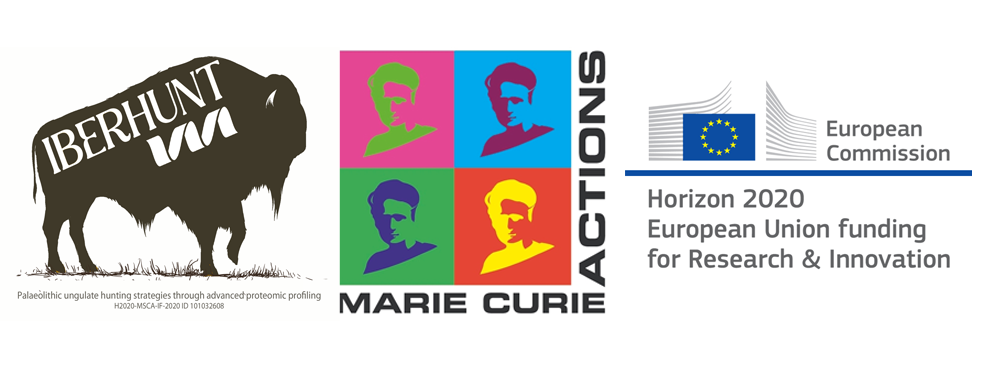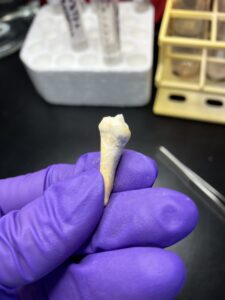Palaeolithic ungulate hunting strategies in the eastern Iberian Peninsula through advanced proteomic profiling

IBERHUNT is a project funded under the EXCELLENT SCIENCE – Marie Skłodowska-Curie Actions 2020 (Grant agreement ID: 101032608) https://cordis.europa.eu/project/id/101032608
To date, there is a lack of sex-based prey data for most Pleistocene bone assemblages, key information for examining the planning ability of Neanderthal hunters. The EU-funded IBERHUNT project will carry out advanced biomolecular analyses in ungulate dental assemblages and sediments from rich-faunal Middle and Upper Palaeolithic sites in the eastern Iberian Peninsula. The goal is to use protein sequences obtained from tooth enamel analysis to determine the sex of ungulate remains and identify palaeoenvironmental biomarkers from the compound-specific isotope ratios of sediment samples.

Wolf (Canis lupus) tooth from the Pleistocene Peștera Muerii site (Romania)
Recent zooarchaeological analyses have suggested that Neanderthals were skilled hunters. Yet, there is still a vivid debate on whether Middle Palaeolithic human groups were also capable of more effective, and diverse, sophisticated food-processing behaviours, in particular through specialised hunting. Traditionally, archaeologists have relied on the osteological analysis of bone assemblages to determine prey mortality patterns, where species variability, age and seasonality data are calculated. Although this approach has yielded a great deal of important information about the Pleistocene hominin hunting strategies, there is a considerable lack of sex-based prey data for most Pleistocene bone assemblages, a key information that has direct implications for hominin planning depth, anticipatory abilities, mobility and land use.
IBERHUNT project will conduct advanced biomolecular analyses in ungulate dental assemblages and sediments from rich-faunal Middle and Upper Palaeolithic sites in the eastern Iberian Peninsula. The anthropic occupation deposits range Marine Isotope Stages (MIS) 5 to 3, making them exemplary case studies for comparative-based research.
We aim to address 1) the determination of the biological sex of ungulate remains, by reading protein sequences through the analysis of tooth enamel amelogenin, and 2) the identification of palaeoenvironmental biomarkers, by the analysis of sediments’ compound-specific isotope ratios. This combination of state of the art techniques will provide contextualised and quantifiable high-resolution data on Pleistocene human foraging efficiency, allowing to re-evaluate Neanderthal predatory economics through an optimal foraging perspective that includes climate adaptations.
This project results will bring the discussion of evolutionary relationships between Neanderthals and modern humans in a broader perspective, providing quantifiable high-resolution data on Pleistocene human foraging efficiency, including adaptations to climate change, and will contribute to the development of new methods for archaeological research.
IBERHUNT is hosted at the University of La Laguna (Spain) in partnership with the University of California Davis (US). The active period of the action is 2022-2025.
The two-year outgoing phase is devoted to contribute to the research being developed at the Archaeometry laboratory (PI Jelmer W. Eerkens, Evolutionary Wing of the Department of Anthropology), and the Parker Laboratory (PI Glendon J. Parker, Department of Environmental Toxicology). The one-year incoming phase at ULL is dedicated to contribute to the methods being developed by the Archaeological Micromorphology and Biomarkers Laboratory (AMBI Lab) (PI Carolina Mallol, Instituto Universitario de Bio-Orgánica Antonio González), incorporating the new acquired theoretical and methodological skills.

ARCHAEOLOGICAL SITES
- Cova del Gegant (Sitges, Spain)
- Cueva Des-Cubierta (Madrid, Spain)
- El Salt (Alcoi, Spain)
- Gran Dolina TD10 (Burgos, Spain)
- Les Cottés (Saint-Pierre-de-Maillé, France)
- Peștera Muierii (Gorj, Romania)
OUR REFERENCE COLLECTION includes modern teeth from European bison, cattle, deer, horse, grey wolf and brown bear.
In collaboration with:
